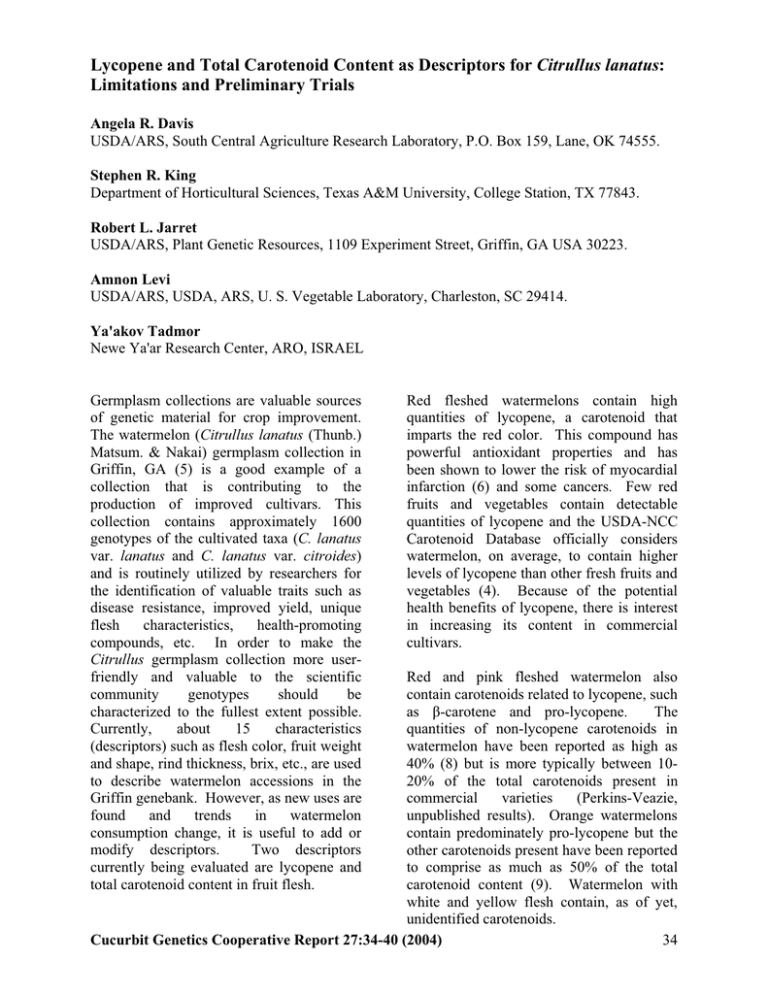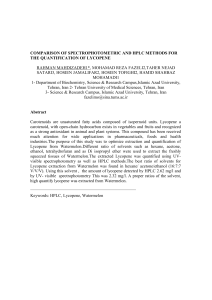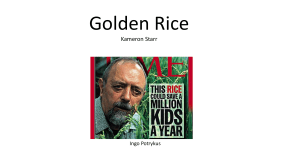Citrullus lanatus Limitations and Preliminary Trials
advertisement

Lycopene and Total Carotenoid Content as Descriptors for Citrullus lanatus: Limitations and Preliminary Trials Angela R. Davis USDA/ARS, South Central Agriculture Research Laboratory, P.O. Box 159, Lane, OK 74555. Stephen R. King Department of Horticultural Sciences, Texas A&M University, College Station, TX 77843. Robert L. Jarret USDA/ARS, Plant Genetic Resources, 1109 Experiment Street, Griffin, GA USA 30223. Amnon Levi USDA/ARS, USDA, ARS, U. S. Vegetable Laboratory, Charleston, SC 29414. Ya'akov Tadmor Newe Ya'ar Research Center, ARO, ISRAEL Germplasm collections are valuable sources of genetic material for crop improvement. The watermelon (Citrullus lanatus (Thunb.) Matsum. & Nakai) germplasm collection in Griffin, GA (5) is a good example of a collection that is contributing to the production of improved cultivars. This collection contains approximately 1600 genotypes of the cultivated taxa (C. lanatus var. lanatus and C. lanatus var. citroides) and is routinely utilized by researchers for the identification of valuable traits such as disease resistance, improved yield, unique flesh characteristics, health-promoting compounds, etc. In order to make the Citrullus germplasm collection more userfriendly and valuable to the scientific community genotypes should be characterized to the fullest extent possible. Currently, about 15 characteristics (descriptors) such as flesh color, fruit weight and shape, rind thickness, brix, etc., are used to describe watermelon accessions in the Griffin genebank. However, as new uses are found and trends in watermelon consumption change, it is useful to add or modify descriptors. Two descriptors currently being evaluated are lycopene and total carotenoid content in fruit flesh. Red fleshed watermelons contain high quantities of lycopene, a carotenoid that imparts the red color. This compound has powerful antioxidant properties and has been shown to lower the risk of myocardial infarction (6) and some cancers. Few red fruits and vegetables contain detectable quantities of lycopene and the USDA-NCC Carotenoid Database officially considers watermelon, on average, to contain higher levels of lycopene than other fresh fruits and vegetables (4). Because of the potential health benefits of lycopene, there is interest in increasing its content in commercial cultivars. Red and pink fleshed watermelon also contain carotenoids related to lycopene, such as ȕ-carotene and pro-lycopene. The quantities of non-lycopene carotenoids in watermelon have been reported as high as 40% (8) but is more typically between 1020% of the total carotenoids present in commercial varieties (Perkins-Veazie, unpublished results). Orange watermelons contain predominately pro-lycopene but the other carotenoids present have been reported to comprise as much as 50% of the total carotenoid content (9). Watermelon with white and yellow flesh contain, as of yet, unidentified carotenoids. 34 Cucurbit Genetics Cooperative Report 27:34-40 (2004) The germplasm descriptor list for Citrullus does not currently contain a descriptor for fruit pigment content. Addition of descriptors that report fruit lycopene and total carotenoid content will make this information available to the industry in an easy to search format. The following potential descriptors were evaluated: maximum lycopene content, range of lycopene content in red fruit, mean lycopene content of red fruit, percent of red fruit, maximum total carotenoid content, range of total carotenoid content in pigmented fruit, mean total carotenoid content of pigmented fruit, and percent of pigmented fruit. Plant Introduction (PI) lines were evaluated in 2000-2003. One to thirteen pigmented fruits from each of eight PI lines was collected for lycopene and six for total carotenoid analysis. Results: Lycopene content in fruit flesh ranged from 10 to 81 µg.g-1 fresh weight (FW). The largest range of lycopene content within a line was 57 µg.g-1 (PI 385964). PI 288232 had the highest lycopene content detected (81 µg.g-1) in one fruit and PI 319212 had the highest overall lycopene content with a mean of 64 µg.g-1 (Table 1). Among the yellow and orange watermelon the total carotenoid content ranged from 3The largest range of total 13 µg.g-1. carotenoid content within the eight lines was 3-13 µg.g-1 (PI 629111). This PI line also had the highest total carotenoid content detected (13 µg.g-1) in one fruit and PI 629111 and NSL 29605 had the highest overall total carotenoid content 8 µg.g-1 (Table 2). Using this data, we developed potential descriptors and descriptor codes for the Citrullus lanatus PI collection. The four descriptors and their codes are listed in Tables 3 and 4. Discussion: These preliminary experiments tested the feasibility of using lycopene and total carotenoid content as descriptors for Citrullus lanatus PI lines and were used to formulate descriptor codes for documenting various carotenoid contents. Although the proposed descriptors are less informative than the actual data values (Table 5 vs. 1 and 2), the codes are consistent with the GRIN database and are in a format that is easy to use with a search engine. Since PI lines are often heterogeneous in their expression and accumulation of carotenoids, just reporting the average carotenoid content would not be very meaningful. Therefore, we suggest reporting the carotenoid content in eight ways: maximum lycopene content, range of lycopene content in pigmented fruit, mean lycopene content of pigmented fruit, percent of red pigmented fruit, maximum total carotenoid content, range of total carotenoid content in pigmented fruit, mean total carotenoid content of pigmented fruit, and percent of pigmented fruit. These eight descriptors supply information on the number of fruit that are pigmented, how many of the pigmented fruit are red versus yellow or orange, amount of lycopene and or total carotenoids in the fruit, and the range of these compounds present in the PI lines. Non-pigmented fruit are not included because they are typically low in carotenoids (unpublished data) and thus would skew the data making it less informative. In this report, total carotenoid content is documented for yellow and orange fruit only, but it is informative to list this trait for red watermelon as well. Since carotenoid profiles are not well characterized for yellow and orange watermelon total carotenoid content is suggested as a descriptor and not descriptors for individual compounds, such as pro-lycopene. Obviously, analyzing more fruit will provide more accurate descriptor data. This is especially true since the production environment can affect lycopene levels by 10-20% (7) and PI lines are often grown in the greenhouse which can reduce carotenoid accumulation. For optimal results we recommend testing at least 10 plants from homogeneous lines and more from lines that Cucurbit Genetics Cooperative Report 27:34-40 (2004) 35 demonstrate heterogeneity for fruit color. We are currently analyzing heterogeneous lines to determine an optimal number of fruit for reporting on these descriptors. Only reporting on ripe fruit is imperative, since under-ripe fruit can have 40% less lycopene than ripe fruit of the same variety (PerkinsVeazie, unpublished data). Methods: Watermelon Fruit: Citrullus lanatus PI lines from the USDA’s Citrullus lanatus germplasm collection in Griffin, GA were transplanted in a 0.5 ha field of Bernow fine sandy loam soil at the South Central Agricultural Research Laboratory in Lane, OK. Seedlings were transplanted in April at the three-leaf stage, on black plastic mulch with drip tape. Plants were 0.9 m apart in a single row 9.1 m in length, 3.6 m between reps, and with a 3.1 m alley separating rows. The cultural methods were performed according to Oklahoma State University Extension guidelines (Bulletin No. F-6236). PI 270546 was grown in the greenhouse in winter 2001 until fruit was ripe. Watermelons were harvested when external appearance suggested ripeness. Ripeness was determined by total soluble solid content, texture, and seed development. Heart tissue from ripe, pigmented watermelons were collected and stored in – 80oC until they were processed. Sample Preparation: All steps from the time watermelons were cut lengthwise were performed in subdued lighting at room temperature. The excised tissue was cut into approximately 2.6 mm3 cubes or smaller. Samples were pureed either fresh or after storage at -80oC. Tissue (25-500 g) was homogenized in a Waring blender until chunks were less then 4 mm3 then pureed using a Brinkmann Polytron Homogenizer (Brinkmann Instruments, Inc., Westbury, N.Y.) with a 20 mm O.D. blade to produce a uniform slurry with particles smaller then 2 mm3. The samples were not allowed to heat or froth. Lycopene Detection Method: This method was performed as in Fish et al.(3). Samples were kept on ice unless otherwise stated. Briefly, approximately 0.6 g (determined to the nearest 0.01 g) duplicate samples were weighed from each puree into two 40 ml amber screw-top vials (Fisher, #03-391-8F) that contained 5 ml of 0.05% (w/v) BHT in acetone, 5 ml of 95% ethanol, and 10 ml of hexane. Purees were stirred on a magnetic stirring plate during sampling. To extract lycopene from the samples, they were placed on ice on an orbital shaker at 180 rpm for 15 min. Then, 3 ml of deionized water were added to each vial and the samples were shaken for an additional 5 minutes on ice. The vials were then left at room temperature for 5 min. to allow for phase separation. Absorbance of the upper, hexane layer was measured in a 1 cm path length quartz cuvette at 503 nm after blanking with hexane. The lycopene content of watermelon was then estimated using the absorbance at 503 nm and the sample weight (3, 1). Total Carotenoid Detection Method: Frozen samples were weighed and homogenized with enough acetone to cover the sample then transferred to a filter paper lined funnel and washed with acetone until all the color was removed. Then 50 ml of hexane was added to the acetone/carotenoid mixture. Water was added to facilitate separation of the layers. The hexane layer was removed, transferred to a 1 cm quartz cuvette and read at 485 nm to estimate total carotenoids (2). Acknowledgments: Special thanks are given to Dr. Julie Collins, Dr. Penelope Perkins-Veazie, and Dr. Wenhua Lu for their thorough reviews. Thanks to Anthony Dillard, Amy Helms, and Ashly Gammon for technical assistance. This work was partially funded by the Cucurbit Crop Germplasm Committee. Disclaimer: Mention of trade names or commercial products in this article is solely for the purpose of providing specific Cucurbit Genetics Cooperative Report 27:34-40 (2004) 36 information and does not imply recommendation or endorsement by the U.S. Department of Agriculture. All programs and services of the U.S. Department of Agriculture are offered on a nondiscriminatory basis without regard to race, color, national origin, religion, sex, age, marital status, or handicap. The article cited was prepared by a USDA employee as part of his/her official duties. Copyright protection under U.S. copyright law is not available for such works. Accordingly, there is no copyright to transfer. The fact that the private publication in which the article appears is itself copyrighted does not affect the material of the U.S. Government, which can be freely reproduced by the public. 4. 5. 6. 7. Literature Cited 1. 2. 3. Beerh, O.P., and G.S. Siddappa. 1959. A rapid spectrophotometric method for the detection and estimation of adulterants in tomato ketchup. Food Technology 13:414-418. Davies, B.H. 1976. Carotenoids. In: T.W. Goodwin, ed., Chemistry and Biochemistry of Plant Pigments, Vol. II. Academic Press, London. pp. 38– 165. Fish, W.W., P. Perkins-Veazie, J.K. and Collins. 2002. A quantitative assay for lycopene that utilizes reduced volumes of organic solvents. Journal of Food Composition and Analysis 15:309-317. 8. 9. Beecher, I.M. Buzzard, S.A. Bhagwat, C.S. Davis, L.W. Douglass, S.E. Gebhardt, D.B. Haytowitz, and S. Schakel. 1999. Carotenoid Content of U.S. Foods: An Update of the Database. Journal of Food Composition and Analysis 12:169-196. Jarret, R.L., M. Spinks, G. Lovell. 1990. Profile: the S-9 plant germplasm collection at Griffin, Gorgia. Diversity. 6:23-25. Kohlmeier, L., J.D. Kark, G.E. Gomez, B.C. Martin, S.E. Steck, A.F.M. Kardinaal, J. Ringstad, T.M. Thamm, V. Masaev, R. Riemersma, J.M. Moreno-Martin, J.K. Huttunene, and F.J. Kok. 1997. Lycopene and myocardial infarction risk in the EURAMIC study. American Journal of Epidemiology 146:618-626. Perkins-Veazie, P., J.K. Collins, S.D. Pair, W. Roberts. 2001. Lycopene content differs among red-fleshed watermelon cultivars. Journal of the Science of Food and Agriculture 81:983-987. Tomes, M.L., K.W. Johnson, and M. Hess. 1963. The carotene pigment content of certain red fleshed watermelons. Proceedings of the American Society of Horticultural Science 82:460-464. Tomes, M.L., and K.W. Johnson. 1965. Carotene pigments of an orange-fleshed watermelon. Proceedings of the American Society for Horticultural Science 87:438-442. Cucurbit Genetics Cooperative Report 27:34-40 (2004) 37 Table 1: Lycopene content analysis for 8 PI lines. PI Number Number of Fruits/Plants Analyzedz Maximum Lycopene Content µg/gy Lycopene Content Range µg/gx Mean Lycopene Content µg/gx % Plants with Pigmented Fruitw NA 270546 1 35 NA 56 288232 4 81 33-81 64 319212 2 76 52-76 44 385964 13 70 13-70 61 525085 2 62 59-62 36 525096 2 44 27-44 55 560000 2 70 40-70 23 482291 5 32 10-32 z Each fruit was harvested from a different plant. y Maximum lycopene content among the fruit analyzed within this PI line. x Range of lycopene content within this PI line. w At least 10 plants were analyzed for this data. 13 100 55 57 75 78 8 95 Table 2: Total Carotenoid content analysis for 6 yellow or orange PI lines. Maximum Total Mean Total Total Carotenoid Carotenoid % Plants with PI Carotenoid Pigmented Content Content Number Content Fruitw x x Range µg/g µ g/g y µg/g 219887 7 3 11 5-11 100 229749 NA 1 7 NA NA 601228 4 3 6 4-6 100 629111 8 2 13 3-13 100 NSL29605 8 3 9 7-9 100 NSL68237 10 3 12 5-12 100 z Each fruit was harvested from a different plant. y Maximum carotenoid content among the fruit analyzed within this PI line. x Range of carotenoid content within this PI line. w At least 2 plants were analyzed for this data if reported. Number of Fruits/Plants Analyzedz Cucurbit Genetics Cooperative Report 27:34-40 (2004) 38 Table 3: List of lycopene descriptors and their codes and definitions for red watermelon fruit. Maximum Lycopene Content Descriptors Range of Mean Lycopene Lycopene Content of Red Content in Red Fruit Fruit Codes 1 2 3 4 5 6 7 Percent of Red Fruit Definitions 10 µg/g 11-25 µg/g 25-50 µg/g 50-75 µg/g 75-100 µg/g 100-125 µg/g 125 µg/g 10 µg/g 11-25 µg/g 25-50 µg/g 50-75 µg/g 75-100 µg/g 100-125 µg/g 125 µg/g 125 µg/g 100-125 µg/g 75-100 µg/g 50-75 µg/g 25-50 µg/g 11-25 µg/g 10 µg/g 0% 1-10 % 11-25 % 26-50 % 51-75 % 76-90 % 91-100 % Table 4: List of total carotenoid descriptors and their codes and definitions for watermelon fruit. Maximum Total Carotenoid Content Descriptors Range of Total Mean Total Carotenoid Carotenoid Content of Content in Pigmented Fruit Pigmented Fruit Codes 1 2 3 4 5 6 7 Percent of Pigmented Fruit Definitions 10 µg/g 11-25 µg/g 25-50 µg/g 50-75 µg/g 75-100 µg/g 100-125 µg/g 125 µg/g 10 µg/g 11-25 µg/g 25-50 µg/g 50-75 µg/g 75-100 µg/g 100-125 µg/g 125 µg/g 125 µg/g 100-125 µg/g 75-100 µg/g 50-75 µg/g 25-50 µg/g 11-25 µg/g 10 µg/g Cucurbit Genetics Cooperative Report 27:34-40 (2004) 0% 1-10 % 11-25 % 26-50 % 51-75 % 76-90 % 91-100 % 39 Table 5: Data from table 1 and 2 listed in descriptor format. PI Number 270546 288232 319212 385964 525085 525096 560000 482291 Number of Fruits/Plants Analyzedz 1 4 2 13 2 2 2 5 Maximum Lycopene Content Range of Lycopene in Red Fruit NA 5 6 4 7 6 5 6 Range of Maximum Total Number of Total PI Carotenoid Fruits/Plants Number Carotenoid in Analyzedz Content Pigmented Fruit 219887 3 2 7 229749 1 1 NA 601228 3 1 7 629111 2 2 7 NSL29605 3 1 7 NSL68237 3 2 7 z Each fruit was harvested from a different plant. Mean Lycopene Content of Red Fruit Percent of Red Fruit NA 4 4 3 4 3 4 2 3 5 5 4 4 3 4 3 Mean Total Carotenoid Content of Pigmented Fruit Cucurbit Genetics Cooperative Report 27:34-40 (2004) 1 NA 1 1 1 1 3 7 5 5 5 6 2 7 Percent of Pigmented Fruit 7 NA 7 7 7 7 40



